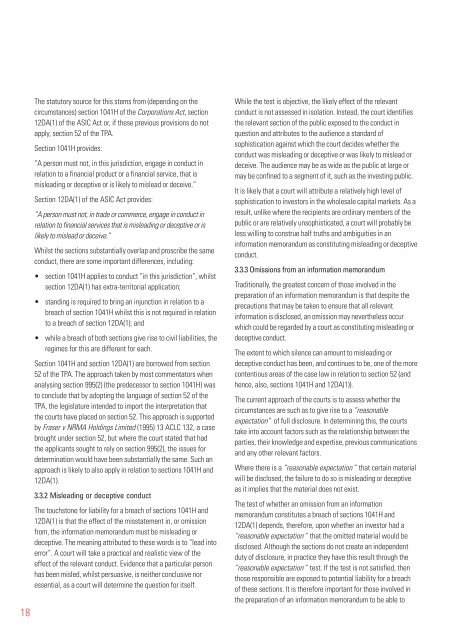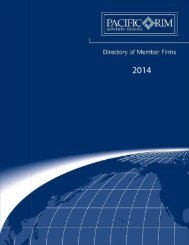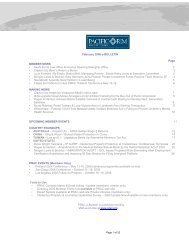A Guide to the Law of Securitisation in Australia - Clayton Utz
A Guide to the Law of Securitisation in Australia - Clayton Utz
A Guide to the Law of Securitisation in Australia - Clayton Utz
- No tags were found...
You also want an ePaper? Increase the reach of your titles
YUMPU automatically turns print PDFs into web optimized ePapers that Google loves.
18The statu<strong>to</strong>ry source for this stems from (depend<strong>in</strong>g on <strong>the</strong>circumstances) section 1041H <strong>of</strong> <strong>the</strong> Corporations Act, section12DA(1) <strong>of</strong> <strong>the</strong> ASIC Act or, if <strong>the</strong>se previous provisions do notapply, section 52 <strong>of</strong> <strong>the</strong> TPA.Section 1041H provides:“A person must not, <strong>in</strong> this jurisdiction, engage <strong>in</strong> conduct <strong>in</strong>relation <strong>to</strong> a f<strong>in</strong>ancial product or a f<strong>in</strong>ancial service, that ismislead<strong>in</strong>g or deceptive or is likely <strong>to</strong> mislead or deceive.”Section 12DA(1) <strong>of</strong> <strong>the</strong> ASIC Act provides:“A person must not, <strong>in</strong> trade or commerce, engage <strong>in</strong> conduct <strong>in</strong>relation <strong>to</strong> f<strong>in</strong>ancial services that is mislead<strong>in</strong>g or deceptive or islikely <strong>to</strong> mislead or deceive.”Whilst <strong>the</strong> sections substantially overlap and proscribe <strong>the</strong> sameconduct, <strong>the</strong>re are some important differences, <strong>in</strong>clud<strong>in</strong>g:• section 1041H applies <strong>to</strong> conduct “<strong>in</strong> this jurisdiction”, whilstsection 12DA(1) has extra-terri<strong>to</strong>rial application;• stand<strong>in</strong>g is required <strong>to</strong> br<strong>in</strong>g an <strong>in</strong>junction <strong>in</strong> relation <strong>to</strong> abreach <strong>of</strong> section 1041H whilst this is not required <strong>in</strong> relation<strong>to</strong> a breach <strong>of</strong> section 12DA(1); and• while a breach <strong>of</strong> both sections give rise <strong>to</strong> civil liabilities, <strong>the</strong>regimes for this are different for each.Section 1041H and section 12DA(1) are borrowed from section52 <strong>of</strong> <strong>the</strong> TPA. The approach taken by most commenta<strong>to</strong>rs whenanalys<strong>in</strong>g section 995(2) (<strong>the</strong> predecessor <strong>to</strong> section 1041H) was<strong>to</strong> conclude that by adopt<strong>in</strong>g <strong>the</strong> language <strong>of</strong> section 52 <strong>of</strong> <strong>the</strong>TPA, <strong>the</strong> legislature <strong>in</strong>tended <strong>to</strong> import <strong>the</strong> <strong>in</strong>terpretation that<strong>the</strong> courts have placed on section 52. This approach is supportedby Fraser v NRMA Hold<strong>in</strong>gs Limited (1995) 13 ACLC 132, a casebrought under section 52, but where <strong>the</strong> court stated that had<strong>the</strong> applicants sought <strong>to</strong> rely on section 995(2), <strong>the</strong> issues fordeterm<strong>in</strong>ation would have been substantially <strong>the</strong> same. Such anapproach is likely <strong>to</strong> also apply <strong>in</strong> relation <strong>to</strong> sections 1041H and12DA(1).3.3.2 Mislead<strong>in</strong>g or deceptive conductThe <strong>to</strong>uchs<strong>to</strong>ne for liability for a breach <strong>of</strong> sections 1041H and12DA(1) is that <strong>the</strong> effect <strong>of</strong> <strong>the</strong> misstatement <strong>in</strong>, or omissionfrom, <strong>the</strong> <strong>in</strong>formation memorandum must be mislead<strong>in</strong>g ordeceptive. The mean<strong>in</strong>g attributed <strong>to</strong> <strong>the</strong>se words is <strong>to</strong> “lead <strong>in</strong><strong>to</strong>error”. A court will take a practical and realistic view <strong>of</strong> <strong>the</strong>effect <strong>of</strong> <strong>the</strong> relevant conduct. Evidence that a particular personhas been misled, whilst persuasive, is nei<strong>the</strong>r conclusive noressential, as a court will determ<strong>in</strong>e <strong>the</strong> question for itself.While <strong>the</strong> test is objective, <strong>the</strong> likely effect <strong>of</strong> <strong>the</strong> relevantconduct is not assessed <strong>in</strong> isolation. Instead, <strong>the</strong> court identifies<strong>the</strong> relevant section <strong>of</strong> <strong>the</strong> public exposed <strong>to</strong> <strong>the</strong> conduct <strong>in</strong>question and attributes <strong>to</strong> <strong>the</strong> audience a standard <strong>of</strong>sophistication aga<strong>in</strong>st which <strong>the</strong> court decides whe<strong>the</strong>r <strong>the</strong>conduct was mislead<strong>in</strong>g or deceptive or was likely <strong>to</strong> mislead ordeceive. The audience may be as wide as <strong>the</strong> public at large ormay be conf<strong>in</strong>ed <strong>to</strong> a segment <strong>of</strong> it, such as <strong>the</strong> <strong>in</strong>vest<strong>in</strong>g public.It is likely that a court will attribute a relatively high level <strong>of</strong>sophistication <strong>to</strong> <strong>in</strong>ves<strong>to</strong>rs <strong>in</strong> <strong>the</strong> wholesale capital markets. As aresult, unlike where <strong>the</strong> recipients are ord<strong>in</strong>ary members <strong>of</strong> <strong>the</strong>public or are relatively unsophisticated, a court will probably beless will<strong>in</strong>g <strong>to</strong> construe half truths and ambiguities <strong>in</strong> an<strong>in</strong>formation memorandum as constitut<strong>in</strong>g mislead<strong>in</strong>g or deceptiveconduct.3.3.3 Omissions from an <strong>in</strong>formation memorandumTraditionally, <strong>the</strong> greatest concern <strong>of</strong> those <strong>in</strong>volved <strong>in</strong> <strong>the</strong>preparation <strong>of</strong> an <strong>in</strong>formation memorandum is that despite <strong>the</strong>precautions that may be taken <strong>to</strong> ensure that all relevant<strong>in</strong>formation is disclosed, an omission may never<strong>the</strong>less occurwhich could be regarded by a court as constitut<strong>in</strong>g mislead<strong>in</strong>g ordeceptive conduct.The extent <strong>to</strong> which silence can amount <strong>to</strong> mislead<strong>in</strong>g ordeceptive conduct has been, and cont<strong>in</strong>ues <strong>to</strong> be, one <strong>of</strong> <strong>the</strong> morecontentious areas <strong>of</strong> <strong>the</strong> case law <strong>in</strong> relation <strong>to</strong> section 52 (andhence, also, sections 1041H and 12DA(1)).The current approach <strong>of</strong> <strong>the</strong> courts is <strong>to</strong> assess whe<strong>the</strong>r <strong>the</strong>circumstances are such as <strong>to</strong> give rise <strong>to</strong> a “reasonableexpectation” <strong>of</strong> full disclosure. In determ<strong>in</strong><strong>in</strong>g this, <strong>the</strong> courtstake <strong>in</strong><strong>to</strong> account fac<strong>to</strong>rs such as <strong>the</strong> relationship between <strong>the</strong>parties, <strong>the</strong>ir knowledge and expertise, previous communicationsand any o<strong>the</strong>r relevant fac<strong>to</strong>rs.Where <strong>the</strong>re is a “reasonable expectation “ that certa<strong>in</strong> materialwill be disclosed, <strong>the</strong> failure <strong>to</strong> do so is mislead<strong>in</strong>g or deceptiveas it implies that <strong>the</strong> material does not exist.The test <strong>of</strong> whe<strong>the</strong>r an omission from an <strong>in</strong>formationmemorandum constitutes a breach <strong>of</strong> sections 1041H and12DA(1) depends, <strong>the</strong>refore, upon whe<strong>the</strong>r an <strong>in</strong>ves<strong>to</strong>r had a“reasonable expectation “ that <strong>the</strong> omitted material would bedisclosed. Although <strong>the</strong> sections do not create an <strong>in</strong>dependentduty <strong>of</strong> disclosure, <strong>in</strong> practice <strong>the</strong>y have this result through <strong>the</strong>“reasonable expectation “ test. If <strong>the</strong> test is not satisfied, <strong>the</strong>nthose responsible are exposed <strong>to</strong> potential liability for a breach<strong>of</strong> <strong>the</strong>se sections. It is <strong>the</strong>refore important for those <strong>in</strong>volved <strong>in</strong><strong>the</strong> preparation <strong>of</strong> an <strong>in</strong>formation memorandum <strong>to</strong> be able <strong>to</strong>






